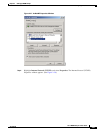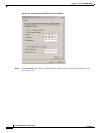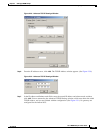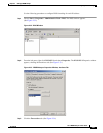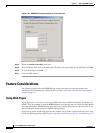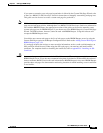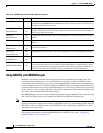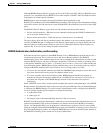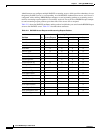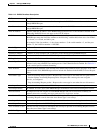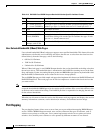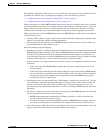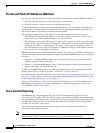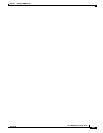
2-39
Cisco BBSM Hotspot 1.0 User Guide
78-15293-01
Chapter 2 Setting Up BBSM Hotspot
Feature Considerations
Port hopping is disabled by default and can only be enabled on a per-port basis by an administrator. For
procedures on different ways to configure port hopping, refer to the following sections:
• “Configuring Your Server (Hotspot Configuration)” section on page 3-1
• “Configuring Ports (Port Configuration)” section on page 3-27
When port hopping is enabled, BBSM Hotspot keeps the session active when the user moves to another
port or temporarily disassociates. For example, disassociation might occur when the signal is weak or an
object comes between the wireless access point and the end user, which causes the user to associate
suddenly with a secondary access point that might be configured to another aggregation switch port.
When a user dissociates from the BBSM Hotspot network, BBSM Hotspot searches for the user until one
of the following occurs:
• The user’s MAC address reappears back on the network within the configured port hop delay time
period. The session then continues without interruption.
• The port hop delay time period expires. BBSM Hotspot then deactivates the session, and the user
must reauthenticate to regain Internet access.
Note the following about port hopping:
• Searching for end user—When port hopping is enabled and an end user disappears from the network,
BBSM Hotspot begins searching for the end user. BBSM Hotspot searches all configured network
elements. It first searches the last known network element that the end user was connected to or
associated with. If the user is not found, BBSM Hotspot then searches all other configured network
elements until the end user is found or the port hop delay time period expires.
• Session duration—The reported duration of an active session varies depending on how the session
terminates:
–
If the search succeeds, BBSM Hotspot includes the time that it searched for the user in the
session duration.
–
If the search fails to find the user before the port hop delay time period expires, BBSM Hotspot
does not include the search time in the session duration. In this way, the user that terminates a
session by turning off the computer is not charged for the time that BBSM Hotspot spends
searching for the user on other ports.
• Port hopping from a port hop disabled port—Port hopping is enabled on a per-port basis. The end
user is allowed to hop from a port hop enabled port to any port on the same site and continue the
session even if the port hop status of the destination port is disabled. However, the user is not
allowed to hop from a port hop disabled port at all. If this is attempted, BBSM Hotspot deactivates
the session.
• Port policy—As the user hops from port to port, the port policy that BBSM Hotspot associates with
the user session follows the user to each new port:
–
BBSM Hotspot applies the bandwidth limit (in kbps) specified at session activation to the
session as the user moves from port to port.
–
If a user has selected a dynamic bandwidth boost from a BBSM Hotspot web page, when the
user moves to another port, the bandwidth boost settings follow the session to the new port.
• Active Ports report—While the system is searching for a user, the user session remains active and
appears in the Active Ports report as associated with the last used port.



